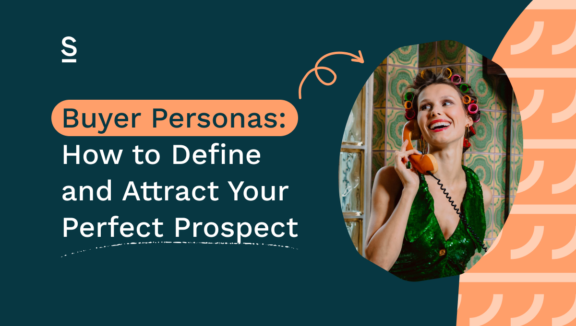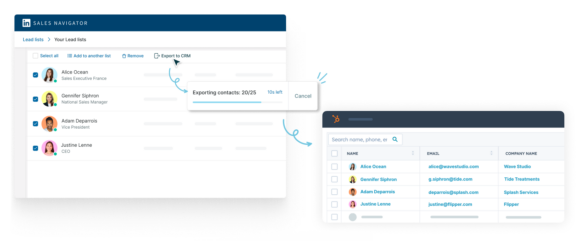Buyer Personas: How to Define and Attract Your Perfect Prospect

“We are all different. And that’s good.”
As a salesperson, you know that no two customers are exactly the same. Whoever you sell to will have their own unique pain points, their own budgetary constraints and their own idea of how your product and service can help achieve their business objectives.
But understanding the common threads, the concerns, needs and drivers, that weave your customers together can be a powerful tool to reach more prospects and make more sales. Defining your buyer personas can be an effective way of grouping your customers, so that you can tailor your sales outreach communications to each persona group based on their specific situation.
If you have a broad target market, and you sell to founders, mid-level managers and investors based across multiple geographies, the chances are that sending a one-size-fits-all cold email just won’t cut it. By getting into the heads of these different subsects of your customer base, and clearly outlining what they are looking for from your product or service, you can improve the efficiency of your sales function and ultimately convert more leads. So, let’s get into it.
In this blog, we’ll cover:
What are Buyer Personas and Why Do I Need Them?
Supercharging Your Sales Lists with Insights and Data
Tailor-made Value Propositions
What are Buyer Personas and Why Do I Need them?
Think of a buyer persona like a fictional character who you want to sell to. Based on market research and audience analysis, your buyer persona will be an imaginary profile of one of your ideal customers who has specific identifiable character traits found in your wider target market.
Rather than describing a potential customer who you can’t yet reach but might hope to in the future, a buyer persona is a representation of real prospects already in your market. If you sell to a diverse range of prospects, you will likely develop multiple buyer personas; and you should tailor your sales strategy depending on the unique circumstances of each persona.
Using buyer personas might sound like more work than a simple blanket mass email across all of your lists. You might ask yourself – can I afford to spend the extra time?
By segmenting your sales communications you’ll have a better chance of reaching buyers that are interested in what you have to sell. In fact personalized emails achieve an open rate of 29% and an outstanding click-through rate of 41%. So the question is – can you afford to not use buyer personas?
How to Build Your Buyer Personas
Establishing your buyer personas should be the very first step in the sales cycle. It helps guide the direction of travel for your sales strategy, and you’ll want to refresh your buyer personas regularly to ensure you are still prospecting the right potential customers. To create your buyer personas, you’ll need to take into account the below characteristics.
- Demographics: Are you targeting a particular age group or customers in a specific location?
- Professional status: Job titles, level of seniority and the industry in which your ideal buyer works will all be vital markers for who you should be prospecting.
- Personality statement: What values or beliefs does your buyer possess about your industry and your product or service?
- Pain points: Identify the specific business challenges this buyer persona is looking to solve. Is it to drive more revenue? Is it to increase brand awareness or to penetrate into new markets?
- Buying process: How does this buyer persona like to be sold to? What are their most active channels? Some buyers will be more responsive to email outreach, while others will prefer social selling tactics depending on their age and industry.
Armed with this information, you can now formalize your buyer personas into written profiles. Get creative here in thinking about the kind of language each buyer persona might use. The more detail you can include in creating your personas, the more useful they will be in helping you tailor your outreach.
Example Buyer Persona
Let’s sketch out what a buyer persona might look like for your business.
Senior Manager Steve
Demographics: 35-50 yrs old, based in London, Bristol, Birmingham and Edinburgh.
Professional Status: Senior Partnership Manager/ Partnership Director, Higher Education Industry.
Personality statement: “Change is slow in Higher Education. I’m risk averse but always want to keep ahead of what’s new in the market. I’m curious about ethical tech, and I like the software we currently use to evaluate potential new partners and measure our success, but I’m open to exploring a new service if the price is right.”
Pain points: Steve has multiple stakeholders to convince the value of our product. His Senior Leadership Team consists of 6 directors, and his budgets are under more scrutiny than ever because of funding cuts.
Buying process: Prefers to be sold to via LinkedIn, uses emails for official communications and to store important documentation.
Exporting Your Lead List to Your CRM with Surfe
Once you’ve gathered your insights and have produced your personas, it’s time to compile your tailored sales list based on the characteristics you’ve defined in your persona and adding it to your CRM system. With a chrome extension like Surfe, you can do this natively within LinkedIn Sales Navigator and then export the list directly to your CRM.
Step 1: Build Your List in LinkedIn Sales Navigator
Open LinkedIn Sales Navigator and use its advanced search filters to build a target list of potential prospects. Apply search criteria that match your buyer personas and pinpoint the exact demographic of professionals you aim to engage with.
Step 2: Export the List to Your CRM System
Select the leads that you want to export. You’ll see a new button Surfe has added that says “Export to CRM”. Simply click it… and watch the magic happen. You’ll see a panel in the corner telling you the progress of your export and Surfe will do all the legwork in the background. All the contacts are now in the CRM and Surfe even enriches them with verified email addresses and phone numbers too!

Supercharging Your Sales Lists with Insights and Data
You’ve built and exported your lists for each persona, and you’re delighted to see that you have 400 hits in one list. Great work! But you know you only have time to outreach to say, 50% of these contacts. How do you decide which contacts are most likely to respond to your sales activity? Enriched data and sales insights can be a huge factor in helping you prioritize which prospects to pursue.
Buyer Intent Data
Has a prospect visited your sales page recently? How many times have they searched for your business name in Google and LinkedIn? Has the prospect recently downloaded any of your thought leadership content? Traces like these can be great indicators that a prospect is primed to buy your product or service. We call these traces buyer intent data, and they are a goldmine for helping you understand your prospects’ buying behaviors. Use resources like your website analytics, your CRM data and your email marketing tools to get a clearer picture of how ready your prospects are to commit to a purchase.
Contact Data
Can you actually reach the prospects on your lists? Without an up-to-date professional email address or phone number, all of your well-crafted emails will go unread, and your perfectly-rehearsed discovery calls will fall on deaf ears. Lighthouse by Surfe can provide you with 1000s of verified email addresses and phone numbers in just one click. And with a success rate of 93%, our email finder tool will help you reach prospects your competitor can’t.
Suppression data
Suppression data identifies contacts that are unlikely to convert, such as existing customers, unqualified prospects, or individuals who have opted out of communications. By filtering out these less promising contacts, your sales team can concentrate their energy and resources on engaging with potential customers who are more likely to respond positively. This targeted approach not only increases the efficiency of your outreach campaigns but also helps maintain a positive brand reputation by respecting the preferences of uninterested or previously engaged contacts.
Tailor-made Value Propositions
Want to increase engagement in your sales outreach? Consider developing tailored value propositions based on what you already know from your buyer personas. By crafting value propositions that resonate with specific pain points, you can build your prospects’ trust by demonstrating a deep understanding of their unique challenges and desires.
For example, if you are running a discovery call with a junior events manager you might say: “Our attendance tracking tools will give you reliable, comprehensive data on exactly who was in the room, so you know who to send your follow-up content to.”
But to a Head of Events at an international company you might lead with: “We know you need to scale your global teams and get a clearer picture of what is happening in each of your target markets. With our attendance tracking tool, you can get granular detail of each territory’s events, while the dashboard shows the international lay of the land.”
Armed with these personalized value propositions, you can craft custom-built sales outreach communications to increase the chances of converting your lead. Use Surfe to write personalized message templates in LinkedIn and InMail to reflect the specific value proposition of each buyer persona you have developed to land the right message, to the right people, at the right time.
Let’s Wrap it Up
In short, while buyers have their own specific needs and business objectives, finding the pain points and characteristics that unite them can be a powerful tool in transforming your sales strategy. Buyer personas allow you to understand the distinct characteristics, needs, and preferences of your target market, so you can create more personalized and effective outreach plans.
Tailoring your communication to these detailed profiles allows you to address specific pain points and offer solutions that resonate deeply with your prospects. And ultimately convert more leads.

Want to get to know your customers better?
Surfe has you covered. Our Waterfall enrichment finds you the best contact data for your prospect list. So you can tailor your sales outreach to each buyer persona.
Oh, and did we mention it’s free to try?
Frequently Asked Questions (FAQs) about Buyer Personas
What Are Buyer Personas?
- A buyer persona is a fictional profile of one of your ideal customers with specific identifiable character traits found in your wider target market.
Why Should I Use Buyer Personas in Sales?
- Buyer personas can help you tailor your sales outreach to specific pain points your customers are experiencing. This can help with converting more qualified leads and avoiding time spent on unviable outreach.
How Can I Build Buyer Personas?
- You should take five characteristics into account when building your buyer personas: demographics, professional status, personality statement, pain points and preferred buying process.
How Can I Use Buyer Personas to Attract More Customers?
- Buyer personas help you build more accurate prospecting lists and can be used to craft tailored sales outreach communications to increase the chances of converting your lead.


